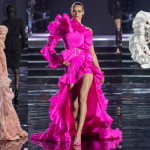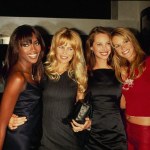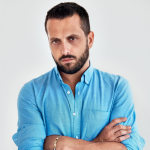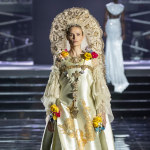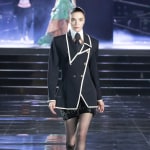Stephen Galloway Can’t Stop Moving

Stephen Galloway has always enjoyed performance. The multi-hyphenate began his creative journey through dance, taking local ballet classes in Erie, Penn., as a child, eventually becoming the youngest dancer to be accepted into the experimental Frankfurt Ballet at the age of 17. During his 25-year tenure with the company, in which he eventually rose to principal dancer under William Forsythe, Galloway experimented with another interest—fashion design. In fact, the dancer would often craft many of the costumes that he would wear to perform.
In the decades since, Galloway’s curriculum vitae boasts more projects and pleasures to count. He has designed costumes for the Paris Opera, creative directed Issey Miyake, choreographed sets for the Rolling Stones (Galloway has been a “special consultant” to the band for 15-plus years), and become a third brain to photographers Inez van Lamsweerde and Vinoodh Matadin. His runway work in particular for the likes of Yves Saint Laurent and Versace has earned him the title the “Model Whisperer.”
As choreographer for CR Runway, he was tasked with recreating the attitude of the ‘90s through a cast of new and old faces on a modern catwalk. Here, Galloway, who draws much inspiration from the time period, reflects on the sights and sounds of the decade.

How did the ‘90’s culture shape you creatively and professionally?
“Through its music, of course! The late ‘80s and early ‘90s was the time that the MTV generation was at its peak. Music, fashion, dance were all mixed together, and that left a strong impression on me and how I approach all of my work today. It was also when all the great European choreographers—like Jiří Kylián, and, of course, my [then] boss, William Forsythe—were traveling all the time. In one night in Paris you could see Pina Bausch, the next you could see Mats Ek and the Cullberg Ballet. That doesn’t happen anymore. There was also the element of hope. Everyone was looking toward the future in the ‘70s. And then the ‘80s came and it was all about the power—we didn’t want power dressing anymore. In the ‘90s, we were all wondering what the 2000s were going to be like, so everyone was very excited about what was coming up. I remember hearing reports about how the clocks were gonna stop—you know, Y2K.”
You thought it was hopeful? I just remember terror; everyone worried about computers shutting down, the world turning off.
“I was looking forward to it. I was waiting to see the blackout; to see how I was going to react. I threw a Y2K-themed party and everything. I even made everyone make sure they brought a survival kit just in case, you know?”
From a dance perspective offstage, are there any popular styles you think really pervaded the time period?
“Dance moves!? Oh god, I’m so bad with dance moves. Social dancing isn’t really a thing for me. Of course I would dance in clubs, but it’s always been more fun for me to watch non-dancers. With professional dancers, there is always the expectation that you perform. So I’m always like, ‘Shows over, I’m just watching and having a good time.’”
What about musical artists—who stands out to you from the ’90s?
“Definitely TLC, Brownstone, and Desiree. I’d say Maxwell, but he was more 2000s. Oh yeah, I’d have Teddy Riley, you know from Guy. That whole New jack swing situation—that would always get a party going.”

So, when you were brought onto CR Runway, what memories did you prepare yourself with to start the choreography?
“I mean, I lived through it. I remember going to shows in Paris at that time, and they were real shows. I remember when a [John] Galliano show would last 35 fucking minutes. His shows back then were just incredible, because you never knew what they were gonna be—the mise-en-scène, the whole scenography. The way he had the girls really move through the rooms or on the runway is something I really miss. That’s why it’s great to have a few of those girls in the show now, because they were really about developing the character, giving them all names. Backstage I’m speaking to the girls like this: ‘Remember this dress. The dress is not wearing you, you have a history, you have an energy you have to bring to it. I do not want you like a soldier running down a runway.’”


